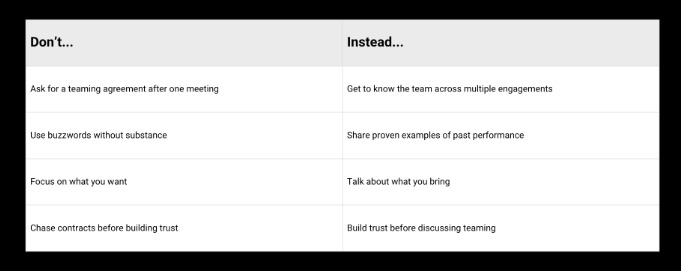Why Do Teaming Efforts Fall Short?
Government contractors don’t struggle to form teams. They struggle to form good ones.
On paper, teaming makes sense: combine strengths, expand reach, and win more work. But in practice, most partnerships don’t get off the ground—or worse, they collapse mid-proposal and it's too late to switch gears.
The real issue? People ask for commitment too fast, with too little context.
NTI’s business development team has seen it firsthand. And in a recent internal session, they put words to something everyone in the federal space has felt but doesn’t often say: if teaming feels like a first date, don’t ask us to get married before dessert.
So why do so many teaming efforts fall short, and how can that be avoided?
The Real Problem: Commitment Without Context
The biggest mistake isn’t lack of interest. It’s lack of patience.
The “let’s team” conversation happens too early, too often. One quick introduction at a conference, maybe a shared contact on LinkedIn—and suddenly there’s a teaming agreement in the inbox. It’s like showing up to a networking happy hour and leaving with a prenuptial agreement.
That speed may feel like momentum. But in reality, it’s skipping critical steps: trust, alignment, and shared understanding.
Meaningful teaming doesn’t happen in one conversation. It takes time, context, clarity, and consistent engagement.
Here's What That Actually Means
“Engagements” don’t mean e-blasts or cold sales pitches. We're talking about real conversations, where both sides bring something to the table.
This includes:
Showing up at local events (and being recognizable while doing it)
Reengaging with familiar faces instead of chasing cold contacts
Introducing team leads and decision-makers to test cultural fit early
It’s about proving—not pitching—what kind of partner you are.
While wearing a Hawaiian-themed polo might seem like a gimmick at first glance, it actually creates consistency and recognizability over time—something most partners underestimate in early-stage teaming. In a sea of badges and handshakes, showing up intentionally and repeatedly matters.
A Common but Critical Mistake: Transactional Thinking
Teaming isn’t just about winning work. It’s about delivering it.
But too many teaming attempts are driven by convenience, not compatibility. One company needs a partner with a certain set-aside. The other needs past performance in a niche domain. A quick meeting, a loose agreement, and the “team” is formed.
That’s not strategy. That’s speed-dating with an invoice.
When those partnerships unravel later—midway through proposal development, or worse, in execution—it’s usually because no one paused to ask: Do we actually know how to work together?
You can avoid this mistake by sticking to a simple principle: no teaming before trust.
What you Should Be Looking for in a Teaming Partner
1. Clarity on Value
What are you actually bringing to the table—beyond checkboxes? Expertise, relationships, delivery history, or unique insight into the mission? Be specific.
2. Cultural Fit
How a partner engages says a lot about how they’ll perform. Transparency, follow-through, and cross-functional awareness matter.
3. Mutual Interest
This is about alignment and shared commitment—not transactional outreach.
Why the “First Date” Analogy Works
One NTI leader put it like this: asking for a teaming agreement on the first call is like asking someone to marry you before the appetizers arrive.
That framing may sound casual—but it’s accurate.
In the same way personal relationships need a foundation, so do teaming relationships. A rushed commitment often masks misalignment. You don’t just need to agree to partner—you need to understand how that partnership will actually work in real-world scenarios: deadlines, bottlenecks, communication styles, and delivery expectations.
By taking the time to engage 7 to 10 times, the team filters out partnerships that are chasing contracts and focuses on those equipped to deliver.
What Not to Do
The goal isn’t just to explain how the team works—but also to make clear which patterns don’t lead to productive relationships.

Who This Isn't For
Not every company is a fit for this kind of teaming approach. And that’s intentional.
If your team is looking for a quick teaming agreement just to check a compliance box, this isn’t for you. If your interest in teaming is transactional—based solely on a contract vehicle, socioeconomic set-aside, or a capability gap—you probably won’t like how long it takes to get to "yes."
This approach isn’t built for firms that only show up when there's a deadline. Or those who disappear after an intro call and resurface at the next recompete. And it’s definitely not designed for anyone who treats diligence like an optional step.
The model is built for organizations interested in long-term collaboration, shared goals, and a structured approach to delivery. If that resonates, the fit will become clear.
What to Expect
When a teaming relationship does move forward, here’s what to expect:
A clear onboarding path that defines roles before anything gets signed
Direct, timely communication—including honest "no-gos"
Multiple meaningful engagements before a formal commitment
A consistent presence and investment in relationship-building
Why This Matters
In GovCon, your performance is only as strong as your partnerships. When teaming goes wrong, it shows up in CPARs, lost re-competes, and reputational drag.
Teaming is one of the most important tools in federal contracting. But it only works when both sides take it seriously. That starts with deliberate engagement, mutual understanding, and a standard of readiness that can stand up under pressure.